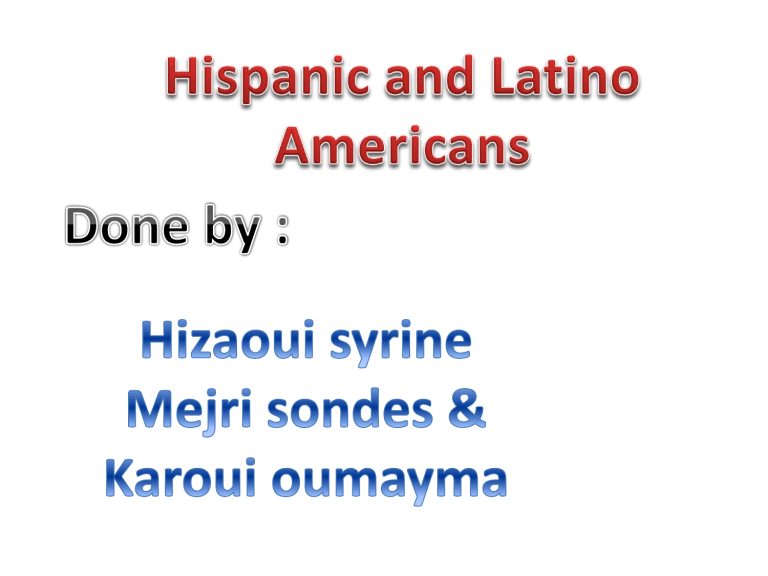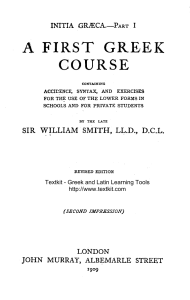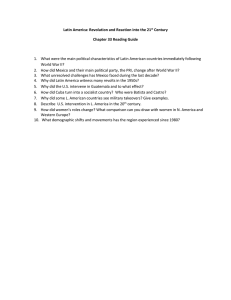
• 1/ Definition of Hispanic and Latino Americans • 2/ History ( first arrival) • 3/ Population & Geographical map • 4/ culture (language , religion , cuisine, family, Media and entertainement , Dance and clothers ) • In the United States, before there was New England, there was New Spain; and before there was Boston, there was Santa Fe. • The teaching of American history normally emphasizes the founding and growth of the British colonies in North America, their emergence as an Independent nation in 1776, and the development of the United States from East to West. • This treatment easily omits the fact that there was significant colonization by Spain of what is now the American Southwest from the 16th century onward. It also tends to ignore, until the Mexican War is mentioned, that the whole Southwest, from Texas westward to California, was a Spanish-speaking territory with its own distinctive heritage, culture, and customs for many decades. • The Spanish-speaking citizens of the United States who were incorporated into the country as a result of the Mexican War are called Mexican Americans. Their numbers have since increased as a result of immigration. • Other Spanish-speaking citizens came from Cuba and Puerto Rico, and smaller numbers are immigrants from Central and South America and from the Dominican Republic. • Taken together, these people are called Hispanics, or Latinos. There are two basic reasons for Hispanic immigration to the United States: economic opportunity and escape from political persecution. • Very large numbers of Mexicans and Puerto Ricans entered the country to escape poverty and to find a way to make a living . The 20thcentury Cuban migration, which began in 1959 when Fidel Castro took over the government of Cuba, was mainly for political reasons. • Hispanics today form the fastest-growing ethnic minority in the United States , they make up the second largest minority in the nation. • Hispanic Americans and Latino Americans make up more than 18% of the U.S population with over 57 million Hispanics and Latinos living in the U.S. • Although there are Hispanics in most parts of the United States, some areas have especially large concentrations. • 86 percent of Mexican Americans make their homes in five South western states: Texas, California, New Mexico, Arizona, and Colorado. • Texas and California account for more than 50 percent of the total Hispanic population in the United States. About two thirds of Puerto Ricans residing in the United States are in the New York City area, including nearby and New Jersey. • About 60 percent of Cuban Hispanics reside in Florida, with the heaviest concentration in Dade County (Miami). • Another 20 percent are in the New York-New Jersey area, particularly in Union City, N.J. Illinois also has large numbers of Mexican, Puerto Rican, and Cuban Hispanics--mostly in Chicago. Map of Latino and Hispanic population in US : • Hispanic and Latin Americans come from diverse social, economic, and geographic backgrounds making them all very different depending on their family heritage and national origin. However, there some cultural similarities that tend to bring these diverse backgrounds together. • One of the most common cultural characteristics of Hispanic American culture is the Spanish language. • In 1980, there were roughly 11 million Spanish speakers in the U.S. representing 5% of the population according to the Pew Research Center. • By 2012 the number of Spanish speakers increased to over 38 million, representing 13% of the U.S. population. Hispanic families often teach their children Spanish as a way of passing down their heritage and culture. • This emphasis on bilingualism has helped revive the Spanish language in the U.S. Religion : • Religion plays an important role in Hispanic and Latin American culture. • Hispanic and Latin Americans represent a highly Christian constituency. • According to a study conducted by the Hispanic Churches in American Public Life (HCAPL), the majority of Hispanic and Latin Americans identify as Catholic and Protestant. • Hispanic and Latin American cuisines are very popular in the U.S and have had a significant influence on American cuisine and eating habits. Some of the typical items in Latin American cuisine include corn-based dishes such as tortillas, tamales, and tacos and various salsas and condiments such as guacamole, pico de gallo, and mole. • Tortilla chips and salsa are so popular that they are now one of the highest selling snack foods in the U.S. PICO DE GALLO Guacamole Mole Tamales Tortillas tacos • Hispanic and Latin American culture places a strong value on family. • Hispanics and Latin Americans tend to have large, close-knit families. It is not uncommon for three generations to live in the same household or nearby each other. Grandparents typically play an important role in their grandchildren’s upbringing. • The emphasis on the well-being of the family makes Hispanic and Latin Americans very grouporiented with family gatherings being commonplace. • The U.S. has many Spanish-language media outlets ranging from giant commercial broadcasting networks to local radio stations. • The two largest broadcasting networks are Univision and Telemundo, which provide Spanishlanguage television to the majority of the U.S. • The availability of Spanish-language television has made it possible for Hispanic and Latin Americans to follow the sport of soccer in the U.S. This has influenced the growth in popularity of soccer in the U.S. Music : • Hispanic and Latin Americans have had a big influence on music in the United States. • In 1986, Billboard magazine introduced the “Hot Latin Songs” chart, which ranks the best performing songs on SpanishLanguage radio stations in the U.S. • In 1993, they introduced the “Top Latin Albums” chart, which ranks the top-selling Latin albums in the U.S. The Record Industry Association of America began “Los Premios de Oro y Platino”, meaning “The Gold and Platinum Awards” to certify Latin recordings that contained at least 50% of its content recorded in Spanish. • Numerous Hispanic and Latin American musicians have achieved international fame such as Jennifer Lopez, Christina Aguilera, and Selena. Dance : Rumba: The Rumba has its roots in the Cuban son. The Rumba consists of two quick steps and then a third slower step that takes two beats to execute. Dancers use a box-like pattern to guide their movements. Salsa :The Salsa originated in the Caribbean, although it also has a strong African influence. Couples typically perform this dance together, and it centers on a four-beat combination of two quick steps and a slow step with a pause or tap. Samba: Samba is Brazilian in origin and danced to music of the same name. Many different forms of Samba dancing developed in Brazil, some for couples, and others for individuals -- solo dancing. Samba is one of the most well known Latin dances, especially for its role in Carnival events, where individual dancers perform There are also other types of latin and Hispanic dances such as : _ Bachata _ Cha Cha Cha _ Mambo _ Merengue _ Paso Doble _ Tango _ Macarena _ Conga Clothes : Argentina Brazil Colombia Costa rica Cuba EL Salvador Mexico Nicaragua Panama Peru Sports : Bullfighting is a physical contest that involves humans and animals attempting to publicly subdue, immobilise, or kill a bull, usually according to a set of rules, guidelines, or cultural expectations. The bestknown form of bullfighting are Latin American countries: Mexico, Colombia, Ecuador , Venezuela and Peru . Soccer Soccer is a passion and an important component of the Latin American culture. It’s practically the most religiously followed of sports between young and old and rich and poor. Copa America, the oldest international continental football competition is happening right now and people in Latin America are locos de la cabeza! (out of their mind.) Baseball: This is the sport Cuba and the Dominican Republic are the most passionate about. Many professional players from these countries play in the US Major League Baseball. Basketball: Basketball is a very popular sport in Argentina. Along with the United States, Argentina is the only country to have won five of FIBA’s most important titles in the sport. Literature: • Latin American literature has a diverse history filled with brilliant authors writing in a variety of genres. • Latin American literature is to written and oral works created by authors in parts of North America, South America, and the Caribbean. • From the genres they used to write are : Essays , novel ,short stories ,poems and theatrical Works . • From the most well known writers are : Gabriel Garcia Marquez (Colombia): novelist, short-story writer, screenwriter and journalist . Miguel Asturias (Guatemala): poet, novelist, and diplomat, winner of the Nobel Prize for Literature in 1967 and the Soviet Union's Lenin Peace Prize in 1969 . Gabriela Mistral (Chile) : The first Latin American woman (and so far the only one) to receive a Nobel Prize in Literature . She was a poetic . Isabel Allende (Chile):Allende’s real literary career began only at the age of 40, when she published The House of the Spirits – a novel in the genre of magic realism. Octavio Paz (Mexico) a Mexican poet and diplomat. For his body of work, he was awarded the 1981 Miguel de Cervantes Prize, the 1982 Neustadt International Prize for Literature, and the 1990 Nobel Prize in Literature. References : •http://history-world.org/hispanics.htm •https://edition.cnn.com/2013/09/20/us/hispanics-inthe-u-s-/index.html •https://www.interexchange.org/articles/visit-theusa/latino-hispanic-culture-in-us/ •https://dance.lovetoknow.com/Types_of_Latin_Dance s •https://vamospanish.com/traditional-dress-latinamerica/ •https://hispanicmama.com/2016/06/13/5-mostpopular-sports-in-latin-america/ •https://study.com/academy/lesson/latin-americanliterature-history-authors-genres.html https://therussianabroad.com/10-greatest-latinamerican-writers/ https://www.youtube.com/watch?v=GBt5rMD2aDc


